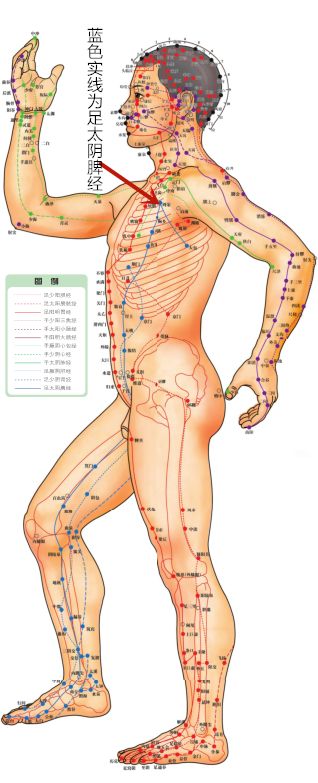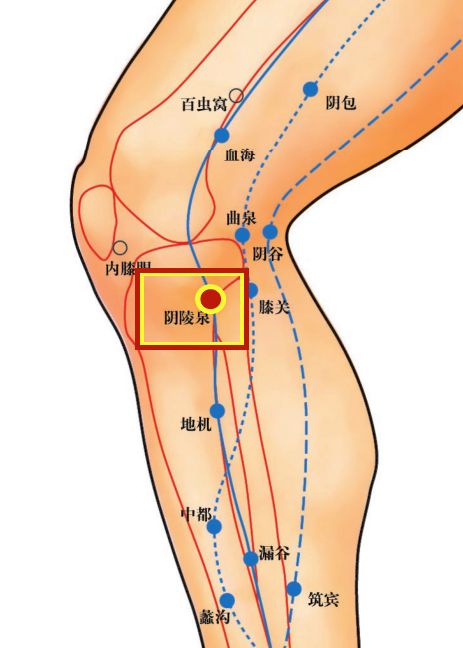Warm Reminder
This section aims to introduce the basic knowledge of acupoints in the human body, allowing everyone to have a fundamental understanding of them and a simple grasp of their application in external therapies such as moxibustion, cupping, and guasha. Many acupoints have high risks associated with needling; non-professionals in acupuncture should not attempt needling operations!
The Spleen Meridian of the Twelve Meridians
🔹 Meridian Pathway
The Spleen Meridian (Zú Tài Yīn Pí Jīng) begins at the tip of the big toe (Yǐn Bái Point), runs along the inner side of the big toe to the junction of the red and white flesh (Dà Dū Point), passes behind the cuneiform bone, and reaches the first metatarsal base (Tài Bái Point, Gōng Sūn Point). It ascends along the front of the inner ankle (Shāng Qiū Point), up the inner side of the lower leg, along the back of the tibia (Sān Yīn Jiāo Point, Lòu Gǔ Point), and intersects with the Liver Meridian (Dì Jī Point, Yīn Líng Quán Point) before continuing upward to the inner side of the knee (Xuè Hǎi Point, Jī Mén Point), entering the abdomen (Chōng Mén Point, Fǔ Shè Point, Fù Jié Point, Dà Héng Point), belonging to the spleen and connecting with the stomach (Fù Ài Point). It passes through the diaphragm, adjacent to the esophagus (Shí Dòu Point, Tiān Xī Point, Xiōng Xiāng Point, Zhōu Róng Point), and connects to the root of the tongue, spreading beneath the tongue.
Abdominal branches: These emerge from the stomach, pass upward through the diaphragm, and flow into the heart, connecting with the Hand Shao Yin Heart Meridian.
The major branch of the spleen: The acupoint Dà Bāo is distributed in the chest and hypochondrium.

🔹 Summary of Indications
This meridian’s acupoints are indicated for spleen and stomach diseases, gynecological disorders, conditions of the lower abdomen, and other symptoms along the meridian pathway, such as abdominal distension, diarrhea, constipation, stomach pain, borborygmus, irregular menstruation, nocturnal emissions, urinary difficulties, mania, eczema, urticaria, lower limb paralysis, and ankle pain.
Acupoint of the Spleen Meridian
🔹 Yīn Líng Quán Point (He Point)
[Source] “Líng Shū: Jīng Mài”
[Location] Located on the inner side of the lower leg, in the depression between the lower edge of the tibia and the inner edge of the tibia.

[Indications]
1. Abdominal distension, diarrhea, edema, jaundice;
2. Urinary difficulties, enuresis, urinary incontinence;
3. Pain in the genital area, dysmenorrhea, nocturnal emissions;
4. Knee pain.
[Application]
Yin represents the opposite of Yang, Ling refers to a mountain ridge, and Quan means spring water. The point is located in the depression below the inner condyle of the tibia, resembling a spring beneath a mountain ridge, hence the name Yīn Líng Quán.
Yīn Líng Quán Point is indicated for abdominal distension, edema, urinary difficulties or incontinence, penile pain, female genital pain, nocturnal emissions, impotence, knee pain, jaundice, abdominal pain, loss of appetite, indigestion, cholera with vomiting and diarrhea, diarrhea, acute and chronic enteritis, bacterial dysentery, enuresis, urinary incontinence, urinary retention, irregular menstruation, dysmenorrhea, vaginitis, leukorrhea, hernia, athlete’s foot, peritonitis, urinary tract infections, intestinal hernia pain, knee joint and surrounding soft tissue disorders, knee arthritis, lower limb paralysis, knee and tibial pain, dysentery, constipation, nephritis, ascites, insomnia, etc.
Regular massage of Yīn Líng Quán Point can effectively treat dizziness, abdominal pain, abdominal distension, urinary incontinence, lumbar and knee pain, dysmenorrhea, and other gynecological diseases. Additionally, massaging this point has a certain weight loss effect, as it can effectively promote the recovery of gastrointestinal function, enhance metabolism, and naturally expel excess toxins and waste from the body, leading to improved body shape.
Regularly massaging Yīn Líng Quán can effectively expel excess dampness from the body, strengthen the spleen, regulate Qi, and benefit the kidneys while also unblocking the meridians. It is particularly effective for conditions such as lumbar and knee pain, body edema, abdominal distension, and diarrhea. Regular stimulation of the body’s resistance will also improve overall health and reduce the likelihood of other diseases. In addition to massage, we can also perform guasha on Yīn Líng Quán Point. We can choose to sit or lie down and use a guasha board on this acupoint, which can effectively treat excessive dampness in the body and promote health.
Massage Method: Hold the area below the knee with both hands, bend the thumbs, and apply pressure upwards to massage Yīn Líng Quán Point for 1-3 minutes each time, which can relieve abdominal pain and knee pain. In the rainy summer, the dampness can obstruct the meridians, so it is advisable to massage Yīn Líng Quán for 10-15 minutes daily.
OrApply moxibustion with 3-5 cones or moxa sticks for 5-15 minutes.
[Literature]
“Huang Di Nei Jing Ling Shu: Si Shi Qi”: “For diarrhea, tonify the three Yin above, tonify Yīn Líng Quán, and retain it for a long time; heat will cease to flow.”
“Huang Di Nei Jing Ling Shu: Re Disease”: “For heat disease with acute pain in the abdomen and fullness in the chest and hypochondrium, use Yǒng Quán and Yīn Líng Quán.”
“Zhen Jiu Jia Yi Jing”: “For excessive gas in the abdomen, abdominal distension, and inability to lie down, Yīn Líng Quán is the main point. For kidney and lumbar pain that cannot bend or stretch, Yīn Líng Quán is the main point. For diarrhea and undigested food, and for cold and heat not being regulated, Yīn Líng Quán is the main point. For female genital pain and hard acute pain in the lower abdomen, Yīn Líng Quán is the main point.”
“Zhen Jiu Da Cheng”: “For cholera, use Yīn Líng Quán, Chéng Shān, Jiě Xī, and Tài Bái.”
“Bei Ji Qian Jin Yao Fang”: “Yīn Líng Quán and Guān Yuán are the main points for cold and heat not being regulated, kidney disease that cannot bend or stretch, and Qi retention with yellow urine; Yīn Líng Quán and Yáng Líng Quán are the main points for incontinence and enuresis; Yīn Líng Quán and Yǐn Bái are the main points for heat in the chest and violent diarrhea.”
*Acupoint images are from the illustrated “Huang Di Nei Jing” published by Zi Tu Books
Cover | Eight Years Old
Editor | Yuan Li

